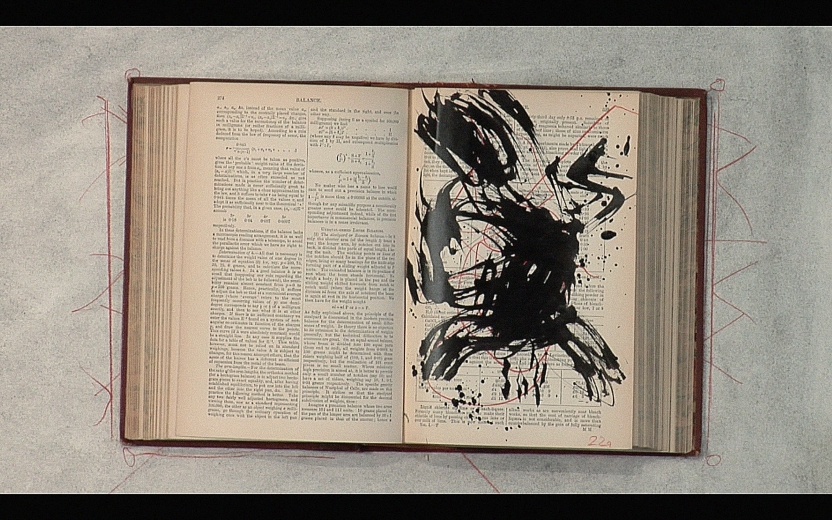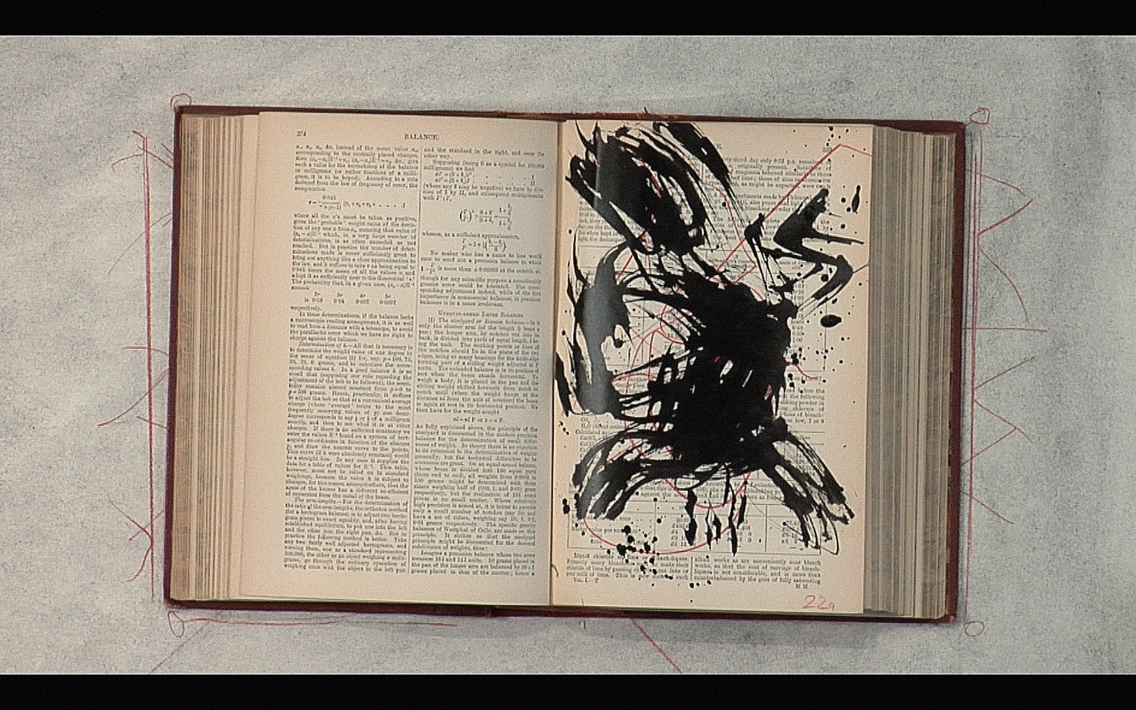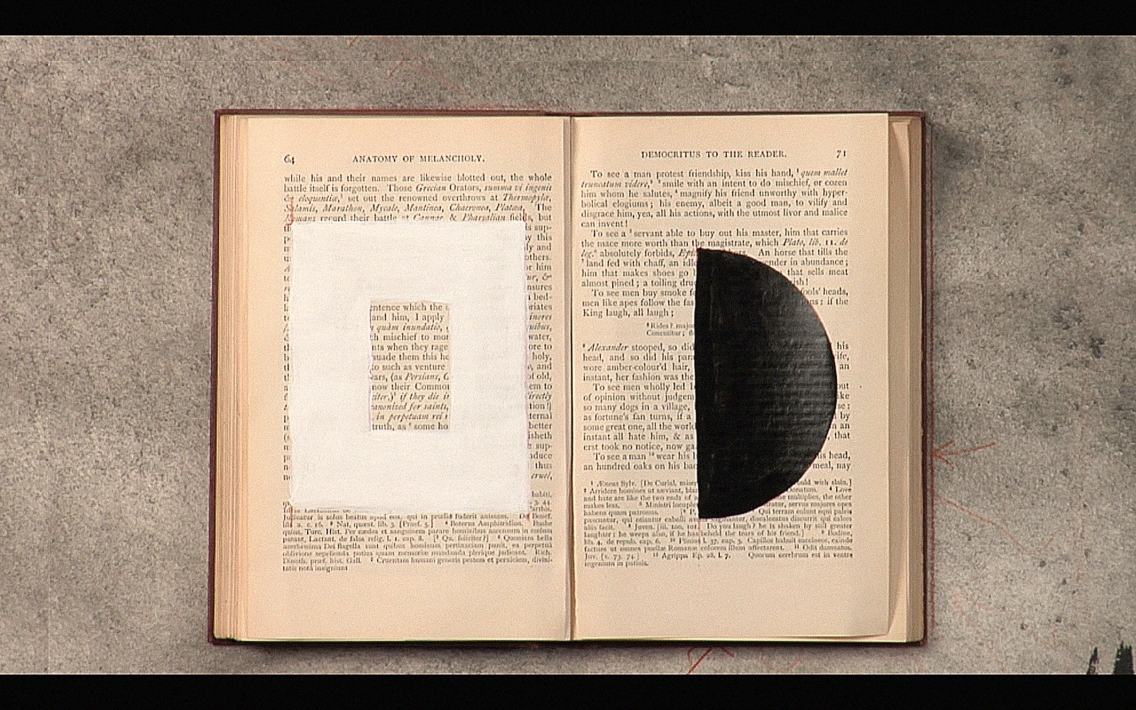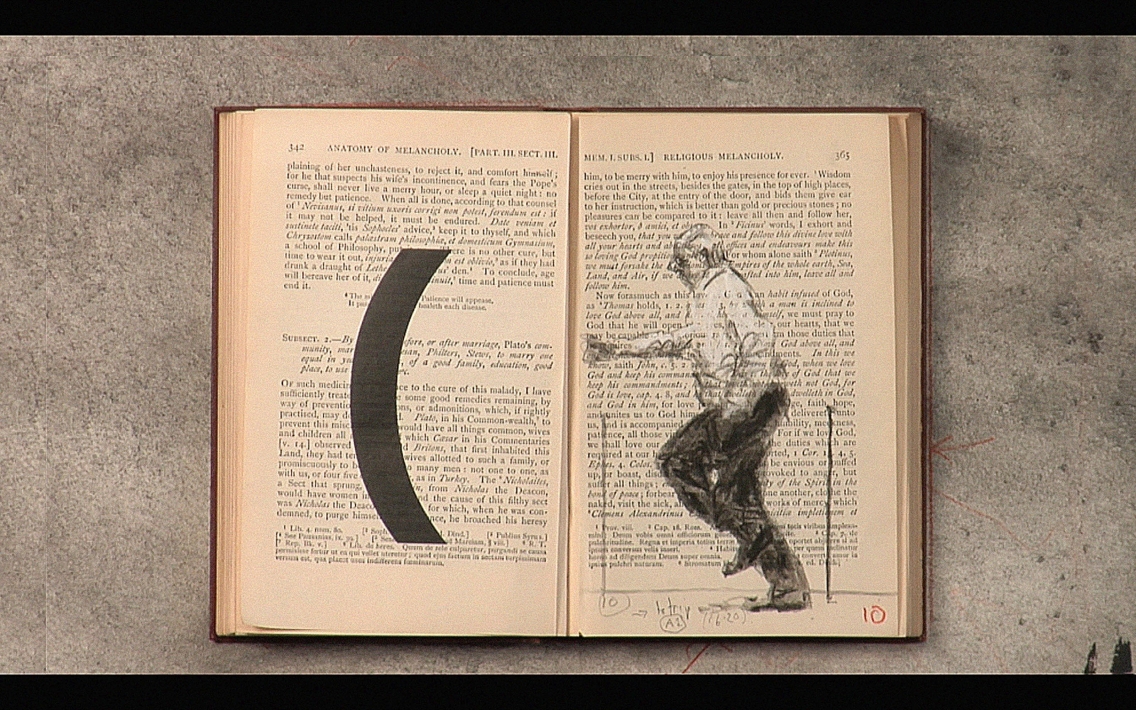Six College and University Art Museums Form New Media Arts Consortium

Inaugural Joint Acquisition is William Kentridge’s Tango for Page Turning
For immediate release
For further information contact: Emmie Donadio, Curator of Modern and Contemporary Art, (802) 443-2240 or donadio@middlebury.edu
Middlebury, VT—A group of six northeast college and university art museums have formed a collaborative partnership, the New Media Arts Consortium, to jointly acquire and share ownership of digital, interactive, and new media works. The partner museums are the Bowdoin College Museum of Art in Brunswick, ME; the Colby College Museum of Art in Waterville, ME; the Middlebury College Museum of Art in Middlebury, VT; the Mount Holyoke College Art Museum in South Hadley, MA; the Rose Art Museum at Brandeis University in Waltham, MA; and the Tang Teaching Museum and Art Gallery at Skidmore College in Saratoga Springs, NY. The Consortium’s inaugural acquisition, Tango for Page Turning (2012–13) by South African artist William Kentridge, will be featured in exhibitions and used in classrooms to enrich interdisciplinary teaching across a wide range of academic fields.

“William Kentridge, Tango for Page Turning still 15” src=”/system/files/william_kentridge_tango_for_page_turning_still_15.jpg” width=”680” height=”425” border=”0” />
William Kentridge, Tango for Page Turning, 2012–2013, single channel HD video, 2 minutes 48 seconds. Purchased by the New Media Arts Consortium, a collaboration of the art museums at Bowdoin College, Brandeis University, Colby College, Middlebury College, Mount Holyoke College, and Skidmore College. Courtesy of the Artist and Marian Goodman Gallery.
The Consortium marks a pioneering approach to collecting new media art, a category that broadly encompasses works originating from video, digital, and computer technologies. The master copy of each acquired work will travel between member institutions for public exhibitions and screenings, and each organization will retain a copy of the work to support research and teaching. Tango for Page Turning will first be exhibited at the Colby College Museum of Art this summer. On view from June 14 through August 21, it will be presented alongside Picasso’s Vollard Suite, another special exhibition highlighting a recent acquisition. The video will be on view at the Mount Holyoke College Art Museum from September 5 through December 17, 2017.
The Consortium will enable the museums to acquire a greater range of works than they would be able to purchase individually, and to draw on the resources and expertise at each institution to create a dynamic and diverse series of courses, learning opportunities for students, faculty collaborations, and programs for their campuses and public communities. All of the museums of the New Media Arts Consortium offer free admission, allowing students, staff, faculty, and the greater public to view the acquired works.
Tango for Page Turning is a single channel video by William Kentridge (b. 1955), best known for his animated films that confront the brutalities of apartheid. The two minute and forty-eight second video of charcoal drawings displays Kentridge’s signature sketching, erasure, and stop-motion animation techniques. Originally created for the chamber opera Refuse the Hour (2012–2013), Tango for Page Turning arose out of a series of conversations between Kentridge and the historian of science Peter Galison on issues including the history of the control of world time, relativity, black holes, and string theory. The video captures the turning pages of a 19th century chemistry book, upon which Kentridge illustrated images of the South African dancer Dada Masilo. Synthesizing music, dance, and poetry, and interweaving historical sources with recent advancements in science, Tango for Page Turning embodies the interdisciplinary framework of the contemporary academic art museum and will serve as a resource for students in a wide range of departments.

“William Kentridge, Tango for Page Turning still 38” src=”/system/files/william_kentridge_tango_for_page_turning_still_38.jpg” width=”680” height=”425” border=”0” />
Credit above
“We are so pleased to be partnering with our college and university art museum colleagues on such an important initiative. Our new consortium will benefit students, faculty, and our broader communities by making accessible major works of contemporary art of innovative media,” noted Bowdoin College Museum of Art Co-Director, Frank Goodyear. “Kentridge’s work touches on so many key elements of the liberal arts—ranging from the history of science to music and dance, to literature, politics, and the visual arts—and the interdisciplinary reach of Tango for Page Turning makes it ideal for a campus collection,” continued Co-Director Anne Collins Goodyear. “The work offers fertile terrain for engagement from multiple vantage points, and we look forward to presenting it at Bowdoin soon.”
“As museums with a shared teaching mission and a commitment to broaden our collective holdings in new media, we saw a unique opportunity to join forces to acquire significant artworks,” said Sharon Corwin, the Carolyn Muzzy Director and Chief Curator of the Colby College Museum of Art. “As a result, we are now able to present to our respective audiences a major work by one of the most respected artists working in video today, while enhancing our engagement with faculty and students. Tango for Page Turning will be the first of many shared acquisitions by the New Media Arts Consortium and is a spectacular first step to launch this game-changing partnership.”
“Tango for Page Turning joins a burgeoning collection of film and video art at Middlebury,” said Emmie Donadio, Middlebury College Museum of Art’s Curator of Modern and Contemporary Art. It will offer colleagues across the performing arts as well as visitors to the museum a close if brief encounter with the deep intellectual and esthetic concerns of William Kentridge, one of the most prolific and respected artists working in all mediums today. We are thrilled to be able to participate in the consortium and to benefit from the stimulating conversations it has already provoked.”

“William Kentridge, Tango for Page Turning still 47” src=”/system/files/william_kentridge_tango_for_page_turning_still_47.jpg” width=”680” height=”425” border=”0” />
Credit above
“With the launch of the New Media Arts Consortium, the study of contemporary, moving image-based art at Mount Holyoke College enters a new phase,” said Mount Holyoke Professor of Film Studies Robin Blaetz. “Just as our students have been able to engage with a remarkable array of the art of the past, they will now have access to some of the most challenging and significant art of their own time. The new media work will provide the missing link that connects the cinema and its practices with both the past and our screen-filled, digital present.”
“Contemporary artists increasingly draw upon digital technologies to make their work, and it is important for us as a teaching museum to weave these works into our ongoing conversation about contemporary creativity,” said Ian Berry, Dayton Director of Skidmore’s Tang Teaching Museum. “We look forward to employing William Kentridge’s fantastic film in our work with students and faculty across disciplines, and to continued collaboration with our partners in the Consortium.”
About the New Media Arts Consortium Partners
The Bowdoin College Museum of Art
The collections of the Bowdoin College Museum of Art commenced over 200 years ago with a major gift from the College’s founder James Bowdoin III and his family, which included Gilbert Stuart’s magnificent portraits of Thomas Jefferson and James Madison. The Museum is housed in the landmark Walker Art Building, designed in 1894 by Charles Follen McKim. Located on the historic quadrangle of Bowdoin College, the building is graced by murals by John La Farge, Kenyon Cox, Elihu Vedder, and Abbott Thayer. A $20.8-million renovation and expansion in 2007 provided a stunning setting for objects as diverse as monumental Assyrian reliefs from Nimrud, Iraq; European old master paintings; and works by American modernists. The Museum is the centerpiece of Bowdoin’s vibrant arts and culture community and offers a wealth of academic and educational programs. Fully accessible, the Bowdoin College Museum of Art is open to the public free of charge from 10 a.m. to 5 p.m. on Tuesday through Saturday; 10 a.m. to 8:30 p.m. on Thursday, and from 1 p.m. to 5:00 p.m. on Sunday. For additional information, please visit bowdoin.edu/art-museum.
Colby College Museum of Art
Founded in 1959, the Colby College Museum of Art comprises five wings, more than 8,000 works of art, and more than 38,000 square feet of exhibition space. Major works by American masters including John Singleton Copley, Gilbert Stuart, Albert Bierstadt, Winslow Homer, Mary Cassatt, and William Merritt Chase form the core of the historical collection, along with significant holdings of American folk art. The modern movement is represented by important works by artists including John Marin, Marsden Hartley, Georgia O’Keeffe, George Bellows, and Rockwell Kent. The museum also maintains a significant collection of contemporary American art, including works by Alex Katz, Chuck Close, Agnes Martin, Sol LeWitt, Dan Flavin, Kara Walker, Elizabeth Murray, Richard Serra, and Terry Winters. Other principal areas of the collection include Greek and Roman antiquities, European prints and drawings, and early Chinese art. The museum is accredited by the American Alliance of Museums. Admission is free. Hours are Tuesday through Saturday, 10 a.m. to 5 p.m., and Sunday, noon to 5 p.m. It also is open Thursdays until 9 p.m. during the academic year. The public is invited to join the conversation online via dedicated social communities on Facebook, Instagram, and Twitter (@colbymuseum and #colbymuseum). For additional information, please visit colby.edu/museum.
The Middlebury College Museum of Art
The Middlebury College Museum of Art is an integral educational and cultural component of Middlebury College whose mission is to enable visitors to understand more fully the artistic achievements represented by a diversity of cultures. The Museum’s collection of several thousand objects ranges from antiquities to contemporary art and includes distinguished collections of Asian art, photography, 19th-century European and American sculpture, and contemporary prints. Works from the permanent collection and special loan exhibitions are on display throughout the year, and the Museum regularly sponsors lectures, gallery talks, films, school programs, and family workshops. The Museum oversees 23 works of public sculpture sited in various locations around the campus. Admission is free. The Museum is located in the Mahaney Center for the Arts on Route 30. Hours are Tuesday through Friday, 10 a.m. to 5 p.m., and Saturday and Sunday from noon to 5 p.m. For additional information: (802) 443–5007, TTY (802) 443–3155, museum.middlebury.edu, Facebook/Twitter/Instagram/Pinterest as @middartmuseum.
The Mount Holyoke College Art Museum
The Mount Holyoke College Art Museum aims to spark intellectual curiosity and creativity through direct engagement with works of art and material culture. Founded in 1876 with a handful of global artifacts and one Albert Bierstadt painting, the Museum’s holdings now exceed 24,000 objects and continue to grow through gifts and purchases. Particular strengths of the collection are its exemplary Greek, Roman, and Egyptian antiquities; art and artifacts from the indigenous Americas; paintings, sculpture, and decorative art from Europe and the United States; photography, prints, ceramics, and numismatics; and works by women artists. In recent years, the Museum has made significant acquisitions of global contemporary art, including important works by Zanele Muholi, Kiki Smith, Alec Soth, Lin Tianmiao, Kara Walker, Carrie Mae Weems, and others. Through thought-provoking exhibitions and educational programs, the Mount Holyoke College Art Museum serves as a nexus for experiential learning across academic disciplines, and as a resource for the broader community. Admission is free. Hours are Tuesday through Friday, 11 a.m. to 5 p.m., and Saturday and Sunday, 1 to 5 p.m. For additional information, please visit artmuseum.mtholyoke.edu.
The Rose Art Museum at Brandeis University
Founded in 1961, the Rose Art Museum is a center of cultural and intellectual life, serving as a catalyst for artistic expression, a living textbook for object-based learning, and a site for scholarly innovation and the production of new knowledge through art. The museum’s permanent collection of postwar and contemporary art is unequalled in New England and is among the best at any university art museum in the United States. Major paintings by Willem de Kooning, Jasper Johns, Roy Lichtenstein, Helen Frankenthaler, and Andy Warhol anchor the collection, and recently acquired works by Mark Bradford, Al Loving, Jack Whitten, and Charline von Heyl build upon this strength while reflecting the museum’s commitment to works of both artistic importance and social relevance. Through its collection, exhibitions, and programs, the Rose works to affirm and advance the values of global diversity, freedom of expression, and social justice that are hallmarks of Brandeis University. Located on Brandeis University’s campus at 415 South Street, Waltham, Mass., the museum is free and open to the public Wednesday through Sunday, noon to 5 p.m., with extended hours from noon – 7 p.m. on Fridays and Saturdays. For more information, call 781-736-3434 or visit brandeis.edu/rose.
The Tang Teaching Museum and Art Gallery at Skidmore College
The Tang Teaching Museum is a pioneer of interdisciplinary exploration and learning. A cultural anchor of New York’s Capital Region, the institution’s approach has become a model for university art museums across the country—with exhibition programs and series that bring together the visual and performing arts with fields of study as disparate as history, astronomy, and physics. The Tang has one of the most rigorous faculty-engagement initiatives in the nation, the Mellon Seminar, and robust publication and touring exhibition initiatives that extend the institution’s reach far beyond its walls. The Tang Teaching Museum’s building, designed by architect Antoine Predock, serves as a visual metaphor for the convergence of ideas and exchange the institution catalyzes. The Museum celebrates its 15th anniversary in the 2015-16 academic year. Admission to the museum is free (donation suggested). Hours are Tuesday through Sunday, noon to 5 p.m., with extended hours until 9 p.m. on Thursdays during the academic year and until 7 p.m. Fridays during the summer months. For additional information, please visit tang.skidmore.edu. Facebook/TangMuseum, Twitter/@TangMuseum, Instagram/TangTeachingMuseum.
Press Contacts
- Bowdoin College Museum of Art: Suzanne K. Bergeron (207-725-3124 | sbergero@bowdoin.edu)
- Colby College Museum of Art: Julia Esposito (212-715-1643 | julia.esposito@finnpartners.com)
- Middlebury College Museum of Art: Emmie Donadio (802-443-2240 | donadio@middlebury.edu)
- Mount Holyoke College Art Museum: Maggie Finnegan (413-538-3538 | mfinnega@mtholyoke.edu)
- Rose Art Museum at Brandeis University: Nina J Berger (617-543-1595 | nberger@brandeis.edu)
- Tang Teaching Museum and Art Gallery at Skidmore College: Michael Janairo (518-580-5542 | mjanairo@skidmore.edu)
